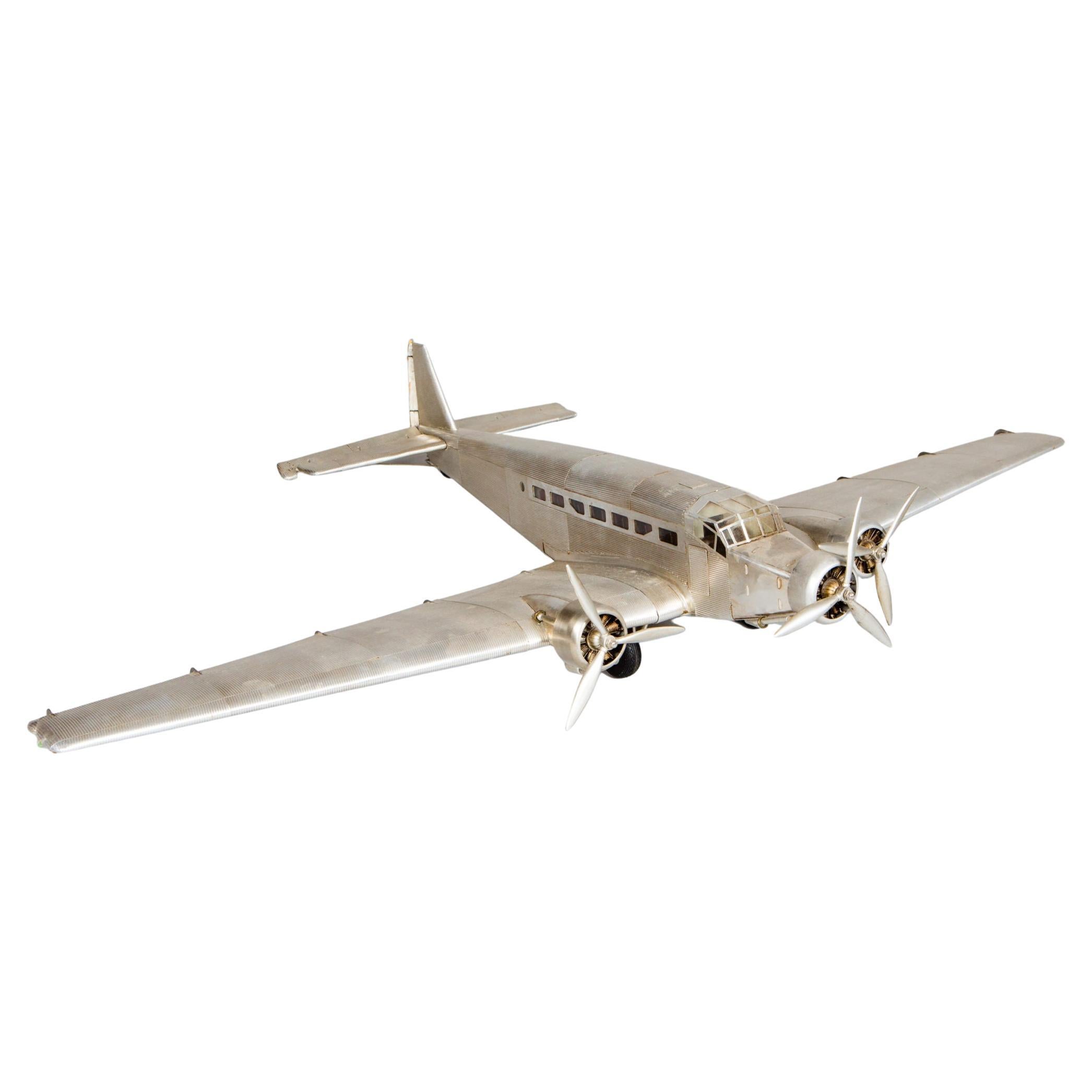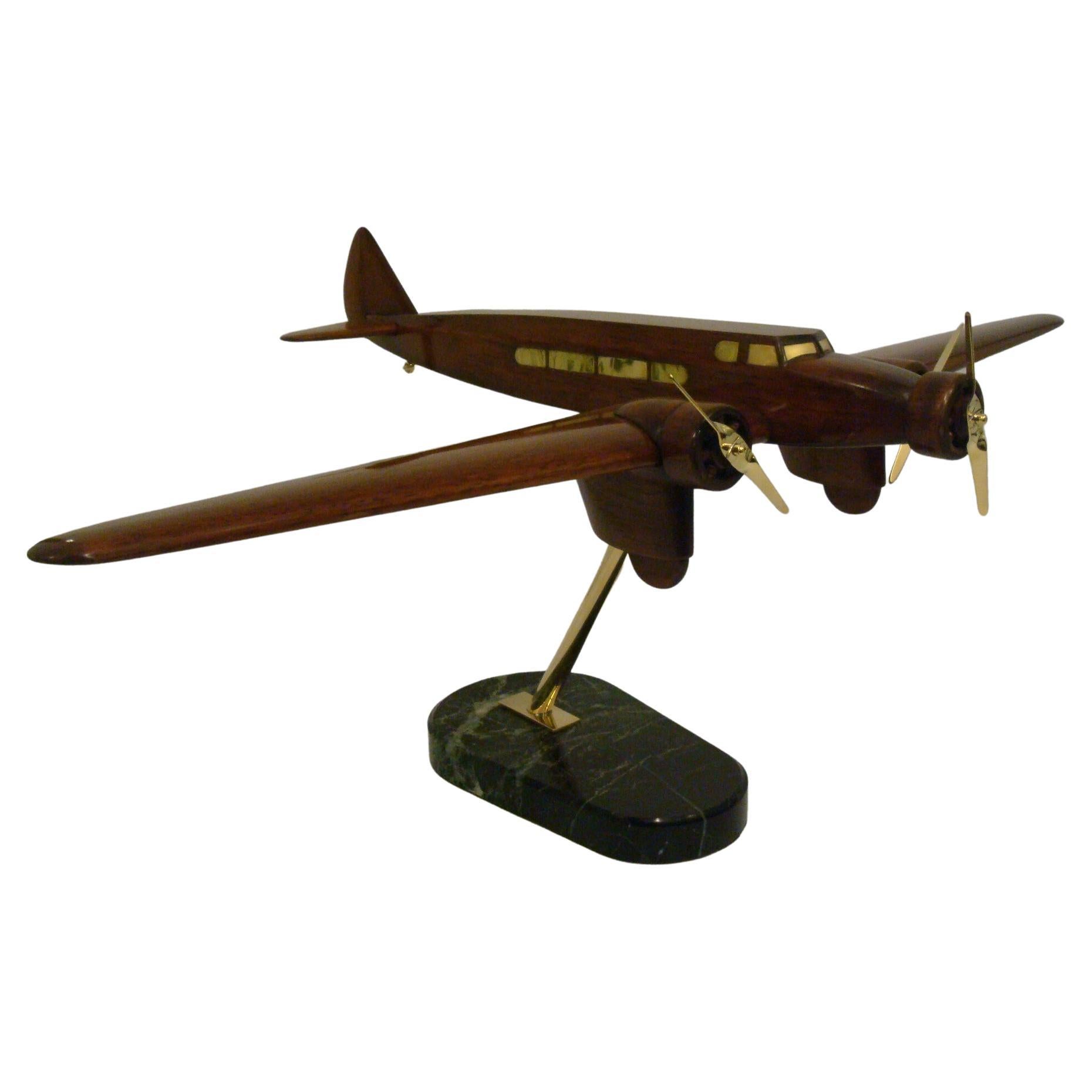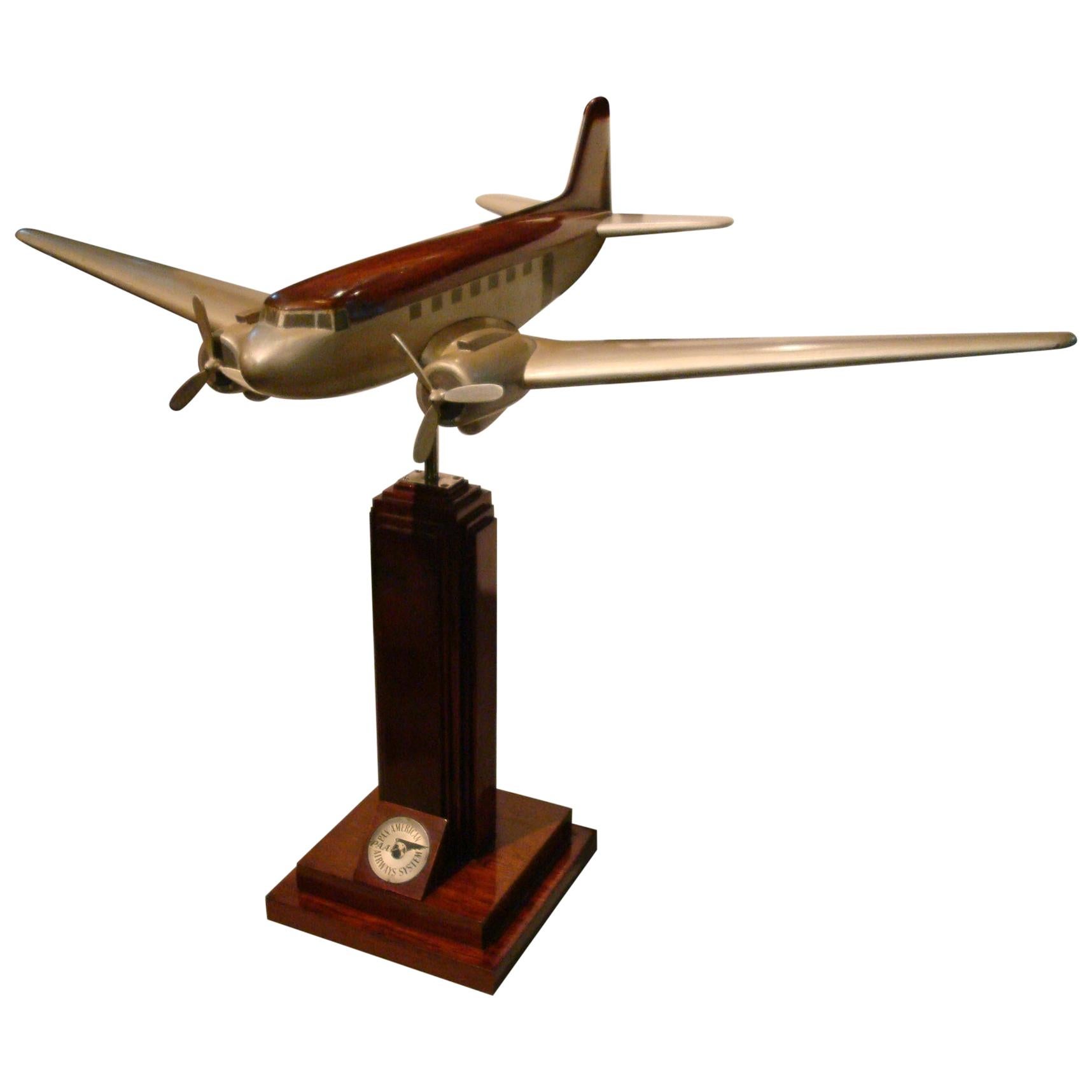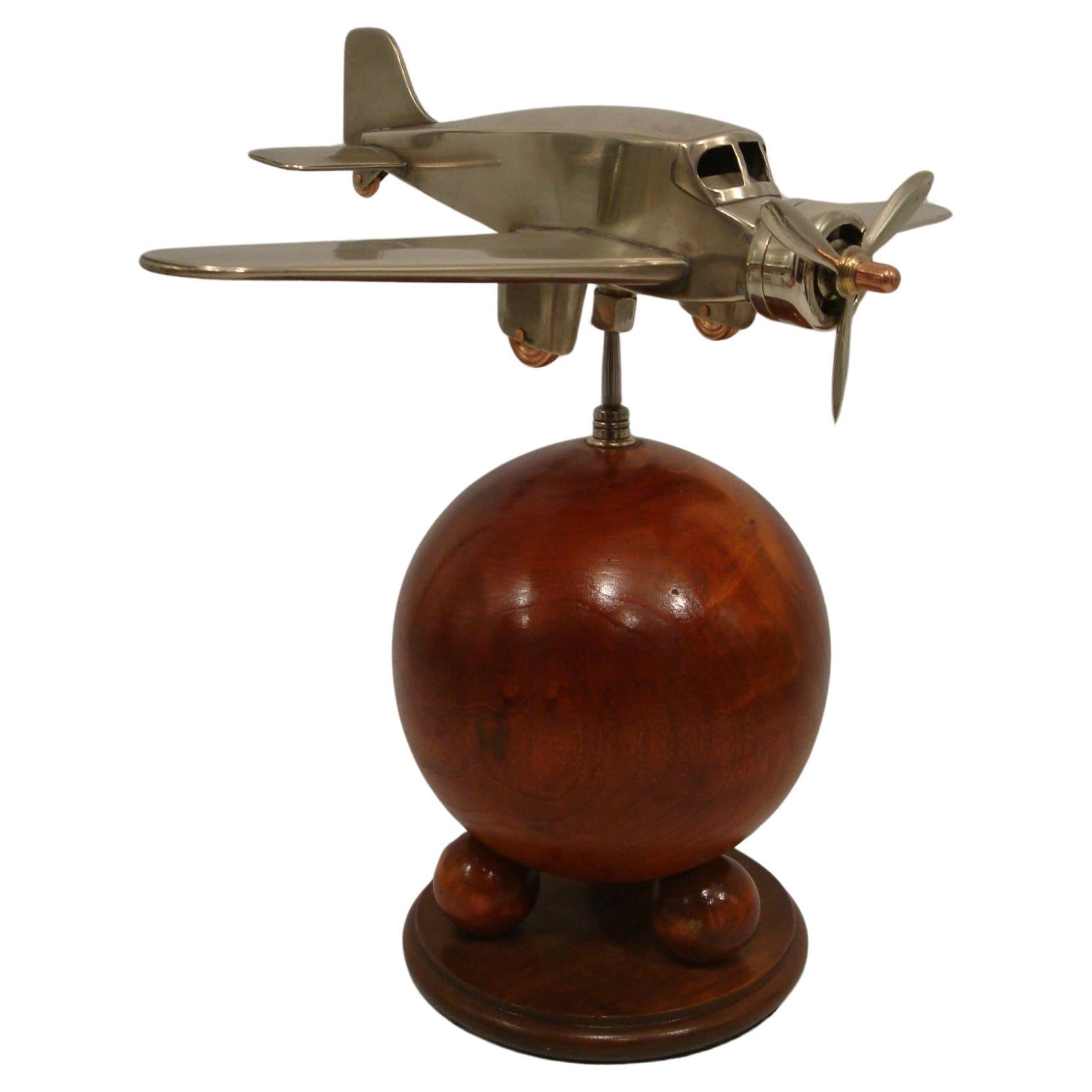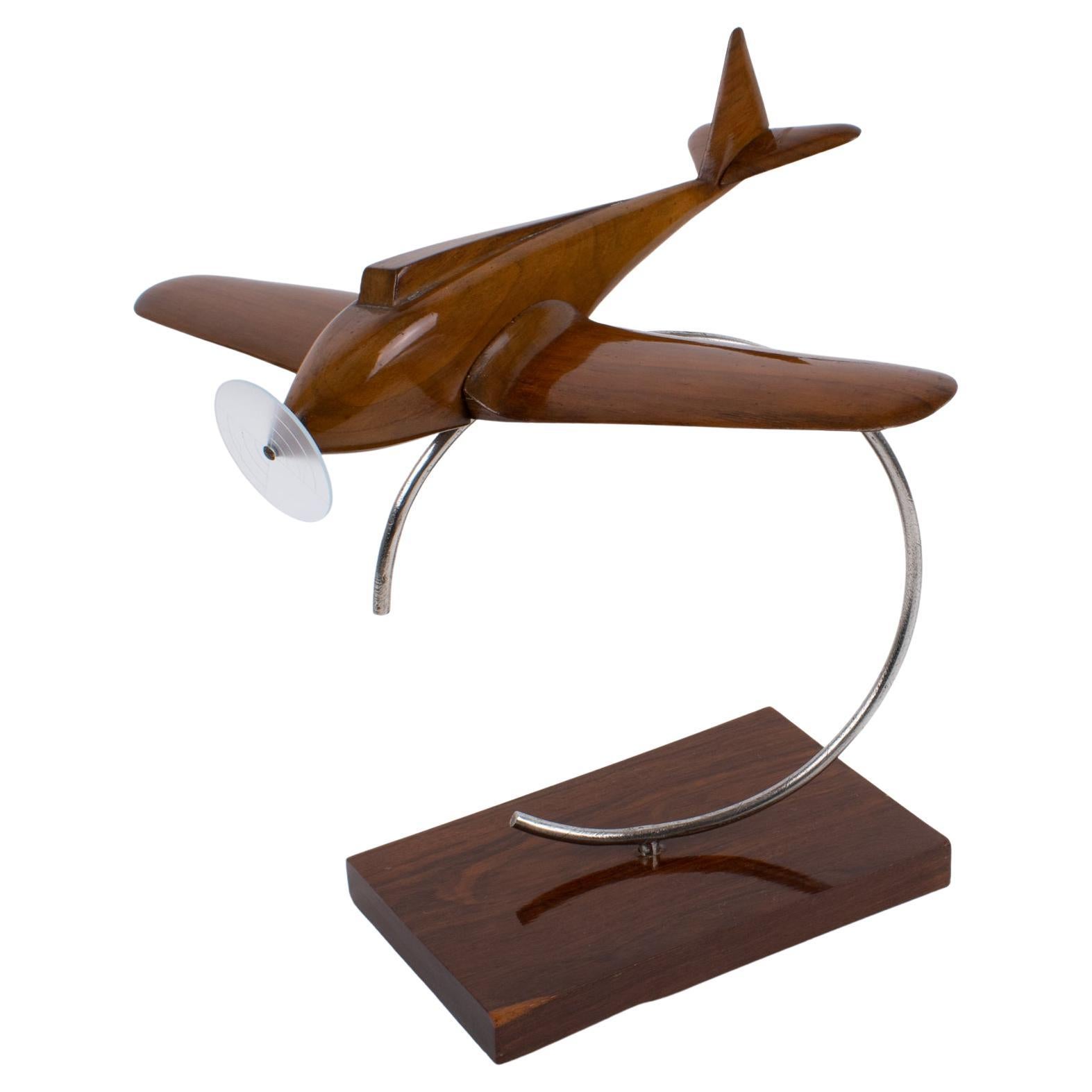Items Similar to Art Deco Ford Trimotor Desk Airplane Wooden Model, ca. 1925
Want more images or videos?
Request additional images or videos from the seller
1 of 11
Art Deco Ford Trimotor Desk Airplane Wooden Model, ca. 1925
About the Item
Art Deco Ford Tri-motor desk airplane wooden model - ca. 1925.
Fantastic desk / counter airplane, made of polished wood and polished aluminium. Fully Restored and ready to display.
Some History:
The Ford Trimotor (also called the "Tri-Motor", and nicknamed the "Tin Goose") is an American three-engined transport aircraft. Production started in 1925 by the companies of Henry Ford and ended on June 7, 1933. A total of 199 Ford Trimotors were made.[1] It was designed for the civil aviation market, but also saw service with military units.
The impact of the Ford Trimotor on commercial aviation was immediate, as the design represented a "quantum leap over other airliners." Within a few months of its introduction, Transcontinental Air Transport was created to provide coast-to-coast operation, capitalizing on the Trimotor's ability to provide reliable and, for the time, comfortable passenger service. While advertised as a transcontinental service, the airline had to rely on rail connections with a deluxe Pullman train that would be based in New York being the first part of the journey. Passengers then met a Trimotor in Port Columbus, Ohio, that would begin a hop across the continent ending at Waynoka, Oklahoma, where another train would take the passengers to Clovis, New Mexico, where the final journey would begin, again on a Trimotor, to end up at the Grand Central Air Terminal in Glendale, a few miles northeast of Los Angeles. This demanding trip would be available for only a year before Transcontinental was merged into a combine with Western Air Service.
Ford Trimotors were also used extensively by Pan American Airways, for its first international scheduled flights from Key West to Havana, Cuba, in 1927. Eventually, Pan American extended service from North America and Cuba into Central and South America in the late 1920s and early 1930s. One of Latin America's earliest airlines, Cubana de Aviación, was the first to use the Ford Trimotor in Latin America, starting in 1930, for its domestic services.
The heyday for Ford's transport was relatively brief, lasting only until 1933, when more modern airliners began to appear. Rather than completely disappearing, the Trimotors gained an enviable reputation for durability with Ford ads in 1929 proclaiming, "No Ford plane has yet worn out in service." First being relegated to second- and third-tier airlines, the Trimotors continued to fly into the 1960s, with numerous examples being converted into cargo transports to further lengthen their careers, and when World War II began, the commercial versions were soon modified for military applications.
- Dimensions:Height: 11.03 in (28 cm)Width: 27.56 in (70 cm)Depth: 16.15 in (41 cm)
- Style:Art Deco (In the Style Of)
- Materials and Techniques:
- Place of Origin:
- Period:
- Date of Manufacture:1925
- Condition:Refinished. Wear consistent with age and use. Excellent Restored conditions.
- Seller Location:Buenos Aires, AR
- Reference Number:1stDibs: LU2027324232572

About the Seller
4.9
Vetted Seller
These experienced sellers undergo a comprehensive evaluation by our team of in-house experts.
Established in 2002
1stDibs seller since 2016
286 sales on 1stDibs
Typical response time: <1 hour
- ShippingRetrieving quote...Ships From: Buenos Aires, Argentina
- Return PolicyThis item cannot be returned.
More From This SellerView All
- Art Deco Dewoitine Wooden Counters Desk Model Airplane 1930s FrenchLocated in Buenos Aires, OlivosArt Deco Dewoitine Wooden Counters Desk Model Airplane 1930s French. The Dewoitine was a Art Deco 1930s French eight-passenger airliner built by Dewoitine. The Airplane was an all-metal cantilever low-wing monoplane. The pilot and co-pilot were seated side by side in a cabin located forward of the wing leading edge. A radio operator station was located behind the pilots, and it had a passenger cabin for eight passengers. The landing gear had trouser-type fairings on the main gear legs. The aircraft first flew on 11 July 1933 powered by three Hispano-Suiza 9V radial engines...Category
Mid-20th Century French Art Deco Aviation Objects
MaterialsMarble, Brass
- Art Deco Pan-Am DC3 Wooden Airplane Desk Model, MidcenturyBy Pan American AirwaysLocated in Buenos Aires, OlivosArt Deco / midcentury large DC3 desk aviation model. Pan-Am wooden airplane model. It was in an office of the company in South America. Very good restored conditions. Slight age wear. History Pan American Airways began the first transatlantic passenger service on this day in 1939. Pan American World Airways, as it was to be known, commonly known as Pan Am, was the principal United States international air carrier from the late 1920s until its collapse on December 4, 1991. Founded in 1927 as a scheduled air mail and passenger service operating between Key West, Florida, and Havana, Cuba, the airline became a major company credited with many innovations that shaped the international airline industry, including the widespread use of jet aircraft, jumbo jets, and computerized reservation systems. The history of Pan American Airways is inextricably linked to the expansive vision and singular effort of one man – Juan Trippe. An avid flying enthusiast and pilot, Trippe, only 28 years old when he founded the airline, lined up wealthy investors and powerful government officials from his personal acquaintances in the high-society of the 1920s. However, Pan Am’s first flight was an inauspicious start to its epic saga. In 1927, facing a Post Office deadline for the commencement of mail carriage, Pan Am had no working equipment for its sole airmail contract between Key West and Havana. Fortunately for Pan Am, a pilot with his Fairchild seaplane arrived at Key West and was willing to carry the mail to Cuba for the start up operation. It is fitting that Pan Am’s first flight would be over water, since the airline would Pioneer overseas routes throughout its history. Pan Am’s fortunes took a turn for the better in the fall of 1927. Through the heavy lobbying efforts of Juan Trippe, Pan Am was selected by the United States government to be its “chosen instrument” for overseas operations. Pan Am would enjoy a near monopoly on international routes. Added to Pan Am’s Cuba route were lines serving Mexico, Central America, the Dominican Republic, Haiti and Puerto Rico. Most of these destinations were port cities, which could be reached only by landing on water. Therefore Pan Am made good use of its “flying boats,” the Sikorsky S-38 and S-40. Flights were eventually expanded to serve much of South America as well. EnlargePan Am’s fleet of Clippers allowed the airline to conquer the Pacific in the mid-1930s. The flying boats would later be put to military use in WWII. Just a few years later, Pan Am launched its effort to cross the world’s largest oceans. Survey flights across the Pacific were conducted with the Sikorsky S-42 in 1935, but passenger service required bigger and better aircraft. Accompanied by much fanfare, the Martin M-130 was introduced in 1936, followed by the Boeing 314...Category
Mid-20th Century Unknown Mid-Century Modern Aviation Objects
MaterialsWood
- Art Deco Brass Airplane desk Model, U.K. 1930´sLocated in Buenos Aires, OlivosArt Deco Brass Airplane desk Model, 1930´s. Lovely Aviation Desk model, made in United Kingdom 1930´s. Excellent restored conditions. The airplane can be...Category
Mid-20th Century British Art Deco Aviation Objects
MaterialsBrass
- Art Deco French Caudron, Renault Desk Airplane Model, Late 1930´sLocated in Buenos Aires, OlivosFrench Caudron - Renault Desk Airplane Model. Late 1930´s. Made of Lacquered Wood and Polished Aluminium The C.710 were a series of light fighter aircraft developed by Caudron-Re...Category
Mid-20th Century French Art Deco Aviation Objects
MaterialsAluminum
- Mid-Century Desk Model Airplane, USA, 1940'sLocated in Buenos Aires, OlivosMid-century desk model airplane - USA 1940´s Single engine fighter. Cast aluminium perior aviation model, mounted over a marble base. Excellent conditions.Category
Mid-20th Century American Mid-Century Modern Aviation Objects
MaterialsAluminum
- Supermarine Spitfire Airplane Model, Desk Sculpture, U.K. 1930´sLocated in Buenos Aires, OlivosSupermarine Spitfire Airplane Model, desk / counters / sculpture. Made in United Kindom 1930´s. Perfect Gift for any pilot or aviation fan. The Supermarine Spitfire is a British ...Category
Mid-20th Century British Mid-Century Modern Mounted Objects
MaterialsAluminum
You May Also Like
- Fokker 1938 Trimotor Model AirplaneLocated in Hudson, NYMetal model airplane with articulating control surfaces and propellers.Category
20th Century German Aviation Objects
MaterialsMetal
- Ford Aircraft Model Trimotor in AluminiumLocated in Paris, FRTrimotor aircraft model Ford handcrafted in aluminum. Manufactured between 1926 and 1933 by Ford's own factory. Wingspan: 102cm.Category
21st Century and Contemporary British Aviation Objects
MaterialsAluminum
- Art Deco Wooden Airplane Aviation Model, France 1930sLocated in Atlanta, GAStylish Art Deco wooden airplane model mounted on a geometric wood and metal display. This Art Deco model airplane is in solid wood with a lovely warm patina. It has one large Lucite...Category
Vintage 1930s French Art Deco Aviation Objects
MaterialsMetal, Copper
- Folk Art Wooden Hand Carved and Painted WW2 Lancaster Bomber Model AirplaneLocated in Hamilton, OntarioThis handcrafted Folk Art model of a Lancaster Bomber is signed on the base, but the artist could not be identified so is posted as Unknown. This wooden airplane model...Category
Late 20th Century Canadian Folk Art Aviation Objects
MaterialsSoftwood
- Large 1930s Ford Tin Goose Tri-Motor Airplane ModelLocated in Peekskill, NYThis is a large delicate tin model made around the same time the real Tin Goose was flying. The wingspan is an impressive 40 inches. The wheels are rubber and the 4 part windshield is glass. I'm surprised the model survived in such nice and complete condition for about 90 years. We had a custom display stand made for it that brings it to another level. Between 1926 and 1933 some 200 Trimotors were built in Ford's own factory. Corrugated metal on great thick monoplane wings was a German development, used in Junker JU-52 planes that were flying the Berlin-Rome-London route. Trimotors were flown by airlines, oil companies and wealthy individuals. The Ford Trimotor...Category
Early 20th Century Streamlined Moderne Models and Miniatures
MaterialsTin
- Art Deco Wood and Chrome Airplane SeaPlane Aviation Model, France 1940sBy Various MakersLocated in Atlanta, GAA fantastic French Art Deco chrome and wood airplane/seaplane model mounted on a stylized wood plinth. A superbly crafted rendering of the legendary quadri-propellers seaplane, strik...Category
Vintage 1940s French Art Deco Aviation Objects
MaterialsMetal, Chrome
Recently Viewed
View AllMore Ways To Browse
Wooden Models
Wooden Deco
Wooden Art Deco
Used Furniture Los Angeles Ca
Model Military
Vintage Model Trains
Used Furniture In Los Angeles Ca
Wooden Train
Deco Train
Los Angeles Deco
Art Deco Train
Art Deco Los Angeles
Models Plane
Art Deco Collectable Objects
Used Model Planes
Model A Ford
Restored Art Deco Desk
Art Deco Unit
